It has been really freezing today but dry and sunny. Yesterday's walking on the uneven ground of the cemetery and the cobbled streets of much of Paris has taken its toll on Jill's ankle. This morning it was worryingly painful so we resigned ourselves to hobbling slowly between metro stations and taking every opportunity to sit down. This is quite alien to both of us and very frustrating in a city with so much to see in a few days.
Our favourite Paris museum has always been the beautiful Musée de Cluny with its specialist collections of tapestries, paintings, sculptures, stained glass and artefacts dating from the middle ages – roughly defined as 500 AD to 1500 AD. It stands near to the Sorbonne, deserted today except for the police on duty while the students presumably occupy the interior as part of their continuing protest against the CPE.
 Musée de Cluny
Musée de ClunyIt was a joy to spend a morning surrounded by beautiful objects. Jill was able to sit and rest in the circular tapestry room surrounded by the late 15 century hangings depicting the world renowned La Dame a la Licorne. These were woven in the Netherlands for the Le Viste family from Lyons. A rich red background smothered in flowers, fruits, animals and birds surrounds an island of deep blue on which stands the beautifully robed lady flanked on one side by a lion with a standard and on the other by the famous unicorn, half goat, half horse with a long horn on its forehead. There are five tapestries depicting different scenes, one for each of the five senses, plus another one symbolic of purity. They are the most beautiful we have ever seen and a refreshing change from those showing scenes of war. The skill of the weavers at that time commands a stunned respect.
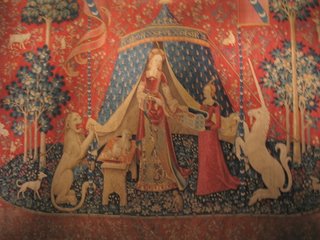 La Dame a la Licorne
La Dame a la LicorneMeanwhile Ian explored the sculptures and remains of the ancient Roman baths, on which site the museum was built. Together we made our way through the galleries of religious paintings, brightly painted mediaeval stained glass and carved wooden statues of the saints. The building itself was as stunning as the exhibits.
 Mediaeval school room
Mediaeval school room Roman baths at the Musée de Cluny
Roman baths at the Musée de ClunyOut in the cold bright streets again we made our way to the Latin quarter along the left bank with its narrow streets of Turkish, Greek and east European shops and restaurants, crowded with visitors and vibrant with life and colour. Here we found a little restaurant where we enjoyed a very good two course lunch in amiable conversation with the French family on the neighbouring table. Together with a demi-carafe of house wine our bill was 18 euros. The area is full of inexpensive restaurants, in part because of its proximity to the student quarter.
Hobbling slowly we made our way to the nearby Ile de la Cité and Notre Dame where we explored the interior and sat to admire its massive 13th century pillars, beautiful stained glass windows, long central nave leading directly up to the high alter without a rood screen and its many tombs to the successive line of Paris's bishops and ecclesiastics.
 Notre Dame de Paris
Notre Dame de Paris Mediaeval stained glass windows, Notre Dame de Paris
Mediaeval stained glass windows, Notre Dame de Paris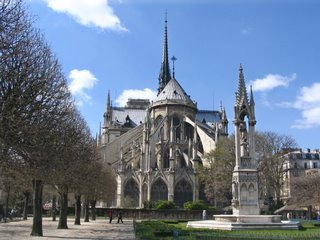 Notre Dame de Paris from the west end
Notre Dame de Paris from the west endA hobble by the swirling rough waters of the Seine brought us to the Conciergerie where Marie Antoinette and other French nobles were held prior to their execution during the Revolution. Then past the beautiful, massive and imposing Palais de Justice.
 La Conciergerie on the banks of the Seine, Paris
La Conciergerie on the banks of the Seine, ParisWe browsed the cheap books and prints displayed by the bouquinistes along the river bank with a view above the buildings to the Tour Eiffel.
 Bouquinistes near the Pont Neuf, Paris
Bouquinistes near the Pont Neuf, ParisThe Pont Neuf was under restoration so were made our way along the Rue de Rivoli to the Place du Châtelet with its tall column of figures in bas-relief commemorating Napoleon's various victories.
 Place du Châtelet, Paris
Place du Châtelet, ParisWe continued to the Centre Georges Pompidou, constructed by Richard Rogers in the 1970s as a piece of Paris, avant-garde architecture. Today it looks somewhat worn and dated but is still a wonderfully enjoyable place to visit with a whole complex of museums and an enormous public library with seating for over 2000 readers. We couldn't visit the library today as there was still a long queue waiting! Nearby stands the pleasant parish church of Saint Merry flanked by some fantastic and quite inappropriate fountains that form part of the Pompidou complex.
 The sublime to the ridiculous – St. Merry and the fountains of the Centre Georges Pompidou, Paris
The sublime to the ridiculous – St. Merry and the fountains of the Centre Georges Pompidou, Paris The sublimely ridiculous – the Centre Georges Pompidou, Paris
The sublimely ridiculous – the Centre Georges Pompidou, ParisInside, the Pompidou Centre is wide and very spacious. This has been achieved by the simple expedient of putting all its working "organs" in the outside in a series of brightly coloured pipes and tubes – red, blue, yellow and green, each representing either plumbing, electricity, ventilation, heating, lifts and escalators. It is a good-fun piece of nonsense that is fully functional. We warmed up here with a coffee watching the crowds milling in and out.
This evening we had been invited to supper by Geneviève's daughter Cécile and to see her flat high in a sixth floor garret of an 18th century apartment block in a very pleasant area of the 18th arrondissement within sight of the Sacré Coeur. Cécile works in Paris as a librarian having formerly been at Biesheim near Colmar (we visited this town back in September.)
So we took the metro to Barbès Rochechouart, exiting into the heart of one of the Arab quarters, the streets thronging with people and full of sound and colour. Here dozens of little shops were all selling fabrics for sewing and dressmaking. We walked up the hill through the steep little streets to emerge at the foot of the steps up to the Sacré Coeur, the gardens to either side full of fresh spring flowers. Despite the cold we still had to pick our way between crowds of visitors resting on the steps.
 Sacre Coeur, Paris
Sacre Coeur, ParisAfter a brief visit to sit down and warm up inside we wandered through the former hilltop village of Montmartre, today a tourist Mecca, full of bohemian painters as it has been since the days of Toulouse Lautrec. Cecile calls it the Bobo area (Bourgeois-Bohemien.)
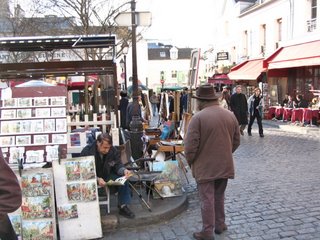 Place du Tertre, Monmartre, Paris
Place du Tertre, Monmartre, ParisDescending through the Place du Tertre past the vineyard that still flourishes here in the heart of the city, and on past the cabaret du Lapin Agile, we made our way down the far side of the hill arriving punctually at 7.30 at Cécile 's flat. We have known Cécile since she was a small child. She is the same age as Kate. It was delightful to have the tables turned on us and to be entertained in her home and to see how happy she is with her home and career. Her brother Etienne is studying here in Paris and joined us for a delightful supper. (Merci beaucoup C et E pour une soirée enchantante.)
 Restaurant and cabaret, Monmartre, Paris
Restaurant and cabaret, Monmartre, ParisIt was nearly midnight when we returned exhausted to our hotel, only to discover there was a very noisy American couple in the room next to ours. Their loud voices, laughter and obscene (to European ears) language made sleep quite impossible and they simply ignored us when on three occasions we knocked and politely asked them to keep quiet. In the end Ian lost his cool, hammering on their door, reminding them of the timezone that they were in - European, rather than Western Seaboard time, and it was now nearly 1am. After that they finally shut-up. Fortunately such a lack of regard for fellow travellers is the exception, most Americans being charming and very friendly. We rarely stay in hotels but when we do we find them far more noisy and disruptive than campsites.
Thursday 6th April 2006
We have received an email from Katie whom we last saw in Caen, saying she is being taken into hospital a week early for the birth of her second baby. We cannot say we are surprised as she looked ready to burst before we went to England! However, this means that our plan to visit her while we are in Paris has been abandoned and her baby is expected to be induced tomorrow.
This morning Jill's ankle had greatly improved but it was still far too painful for much walking. So we made our way to the Jardin des Plantes with its hothouses, formal flowerbeds, zoo, alpine garden and museums of natural history and mineralogy. Most though turned out to be either shut or expensive to visit.
 A passing migrant in the Jardins des Plantes, Paris
A passing migrant in the Jardins des Plantes, ParisWe enjoyed a sunny stroll through the gardens before making our way to the Paris mosque, a large, attractive white complex completed around 1930 and open for visits between prayers. Here we enjoyed a coffee and Turkish pastry in a wonderfully atmospheric room with moorish tiled walls, deep red cushions, engraved brass trays and ceilings with dark wood carved decorations. A cheeky sparrow flew in from the nearby street to finish off our sticky honey-coated sweetmeat.
 Café de la Mosquée, Paris
Café de la Mosquée, ParisLater we were able to leave our shoes at the entrance and visit the mosque where several men were at prayer. Jill was a little nervous as to whether she could go inside as there was a separate door for women but nobody seemed to mind. Strangely we discovered several men lying fast asleep along the walls on the carpeted floor of the mosque! We also discovered the library for the imams with material on the history of Islam and copies of the Koran – at least we think they were but as they were all in Arabic we are not sure. In one of the courtyards green tiles were being carefully re-laid and the fountain had been drained. It will look lovely when completed. Around the complex are rose gardens, currently still dormant. The main courtyard is tiled, surrounded by an arcade of carved horseshoe-shaped arches with a large stone fountain in the centre. It is dominated by a tiled minaret.
 Inside the mosque, Paris
Inside the mosque, Paris Courtyard of the mosque, Paris
Courtyard of the mosque, Paris Courtyard and minaret of the Paris mosque
Courtyard and minaret of the Paris mosqueWe continued to the Arènes de Lutece, built in the second century AD for gladiatorial and theatrical performances. Today it is used as an open space for local office workers to enjoy some sunshine as they eat their lunch.
 Arènes de Lutece, Paris
Arènes de Lutece, ParisFor our own lunch today we made our way to the delightful rue Mouffetard which stretches down the hill behind the rue Monge, flanked on either side by little market stalls and dozens of small restaurants, many from ethnic minorities, offering inexpensive cuisine to suit the needs of everyone. Having a heavy student resident population, prices are low and the road bustling with young people using the local library, queuing for a sandwich, a pancake or a kebab, sitting outside one of the many cafes or just on the stone wall surrounding the flower bed halfway up the hill. Here we found a very nice Greek restaurant specialising in food from Crete. One of the joys of Paris is that you can travel the world without leaving the city! Here, to the accompaniment of Greek music we enjoyed a three course lunch of sweet red peppers and giant Cretan beans in sauce followed by moussaka, rice and a jacket potato and ending with home-made pistachio loukoum (Turkish delight) and coffee. All this for £11 for the two of us!
 Rue Mouffetard, Paris
Rue Mouffetard, ParisDuring the afternoon we continued our Arab theme by seeking out the Centre du Monde Arabe on the banks of the Seine. On the way we had to walk along two complete sides of the huge, unsightly, dilapidated, soul-destroying university of Paris VII. No wonder students are rioting. How can they have hope for the future when obliged to study in such hostile, soulless surroundings with little likelihood of a job at the end of it all? What was in the minds of the architects of the 1960 to build such uninspiring, monolithic blocks for young people to study in? Today it is all the more depressing being covered in graffiti and posters and daubed with political slogans.
 Université Jussieu, Paris VII
Université Jussieu, Paris VIIAround the corner though we found a different kind of monolithic block. The Centre du Monde Arabe has a prestigious site overlooking the river and Notre Dame. Its glass windows have a mesh of cogs that open or close hundreds of little apertures, regulating the amount of sunlight penetrating the glass-sided façade. Inside is a huge, multi-storey library of the Arab world, constructed on six floors with a sloping spiral ramp rather than a staircase linking them together and providing additional shelf space for the bookstock.
 Centre du Monde Arabe, Paris
Centre du Monde Arabe, Paris Notre Dame seen from the sloping ramp in the library of the Centre du Monde Arabe, Paris
Notre Dame seen from the sloping ramp in the library of the Centre du Monde Arabe, ParisBy now Jill was limping badly again and even Ian was exhausted so we took the metro to the Tour Montparnasse rising 59 floors and over 200 metres above Paris. Beneath there was a Breton exhibition extolling the joys of Dinard and St. Malo, complete with bagpipes, oysters and a Breton sailing boat.
 Tour Montparnasse, Paris
Tour Montparnasse, Paris We took the lift, the fastest in Europe, up to the viewing platform on the 56th floor. It took 36 seconds! Here we collapsed exhausted with a beer and looked down on the miniature world of Paris spread out, as far as the eye could see, far below us. Here we were almost on a level with the top of the Eiffel Tower and could see, at a sweeping glance, all the chief monuments of Paris – the kilometre-long building of the Louvre, the Tuilleries, the Sacré Coeur, Les Invalides where the Emperor Napoleon lies in his marble sarcophagus, the Tour St. Jacques, the Pantheon, the Jardins du Luxembourg, the Hotel de Ville, Notre Dame, the Champs de Mars, the Eglise St. Sulpice and the Centre Pompidou. Further off were the Bois de Boulogne and the Bois de Vincennes.
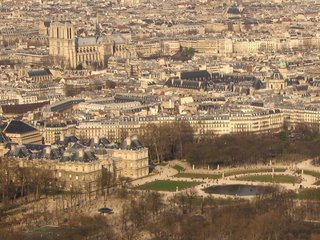 Jardins de Luxembourg and Notre Dame, Paris
Jardins de Luxembourg and Notre Dame, Paris Louvre and Sacre Coeur, Paris
Louvre and Sacre Coeur, Paris 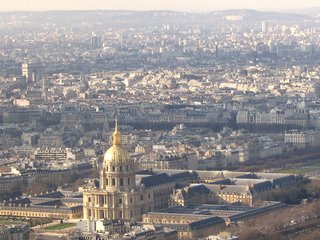 Les Invalides and Arc de Triomphe, Paris
Les Invalides and Arc de Triomphe, Paris 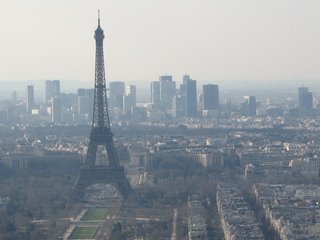 Tour Eiffel and La Defense, Paris
Tour Eiffel and La Defense, Paris Energy partially restored, we finished our beer and made the last three floors on foot out onto the roof. Here we had the dubious pleasure of looking vertically down onto the cemetery of Montparnasse and the railway terminus with the miniature trains rolling in like long, gently writhing serpents. Around the top of the tower runs a metal rail with a cradle attached which is lowered over the side when the windows need cleaning. It must be one of the most terrifying jobs in Paris!
 Gare Montparnasse, Paris
Gare Montparnasse, Paris  Cradles for cleaning the windows of the Tour Montparnasse, Paris
Cradles for cleaning the windows of the Tour Montparnasse, Paris It takes 36 seconds to come down as well! Back in the street it was becoming chilly. We went for a womble on the metro, taking the overground underground to the Trocadero which enabled us to cross the Seine and get a close-up view of the Eiffel Tower without the effort of yet more walking. Finally we returned to our hotel with wine and salad where we collapsed exhausted, counting our blessings that the Americans seem to have moved out from the next room.
Friday 7th April 2006, Caen, Normandy
Today has been warm and sunny. Leaving our computer and luggage at the hotel reception in the safe care of Miss Lilli, the fat grey cat who manages the establishment, we became tourists for the morning, making our way up from the metro into the bright sunshine at the Trocadero and the Palais de Chaillot. Fringed by a long line of Japanese visitors along the balustrade we looked across to the most famous landmark in Paris, the Eiffel Tower. Remember when we were in the Jura we cycled to the deserted iron foundry at Fraisans where the steel structures were forged back in 1889? (See 16th October 2005.) It was from the Palais de Chaillot that Hitler was famously photographed after the fall of Paris in 1940. (A bizarre thought occurred to Jill recalling a faded old photo of herself here, aged 6, photographed on the same spot with her father only a decade later!)
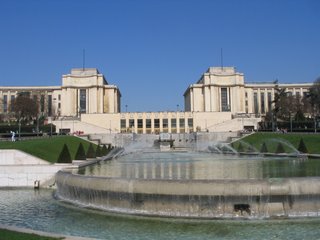 Palais de Chaillot, Paris
Palais de Chaillot, Paris  Can't recall what this is, Paris
Can't recall what this is, Paris The sun was bright and warm as we made our way down the steps and through the formal gardens to stand beneath the huge tower, where at each of the four corners queues waited for the lifts that crawled like tiny yellow ants up each of the huge iron legs to the first floor. From here we strolled along the Champs de Mars, stopping regularly at the request of Italian and Spanish teenagers thrusting their cameras into our hands, to take group photos of them in front of the tower. One lone European asked us in delightfully broken English "Please to take a photograph of here with me" waving his arm generally around indicating the whole of Paris! We settled for one of him with the tower and the Palais de Chaillot behind.
Parisian enthusiasm for symmetry takes precedence over everything else, thus the new monument to Peace is neatly aligned with the Tower and the Palais de Chaillot but stands inappropriately directly in front of the Ecole Militaire!
We made our way from here to the nearby Invalides with its war museums, collections of canons, monuments to the great battles of France and homage paid to everyone from Napoleon's generals to the Resistance fighters and ambulance drivers of the Second World War. We did not join the queues to visit Napoleon's tomb but his statue dominated the huge main courtyard.
 Courtyard of Les Invalides, Paris
Courtyard of Les Invalides, Paris  Les Invalides, Paris
Les Invalides, Paris  A peep at Napoleon, Les Invalides, Paris
A peep at Napoleon, Les Invalides, Paris Paris has always done things on a grand scale. Walking through formal gardens and across massive open squares from one amazing monument to the next, with enticing vistas of avenues and boulevards yet to explore is an exhausting experience. Time was running out and we reluctantly abandoned hopes of visiting the great, glass-domed exhibition centre on the banks of the Seine nearby, descending like moles to the metro – where we were importuned three times by beggars - to speed our way back to Miss Lilli to collect our luggage.
 Miss Lilli the manager of our hotel, Paris
Miss Lilli the manager of our hotel, Paris At the Gare St. Lazare we just had time to buy a sandwich before catching the crowded fast train back to Caen. As we left the station our bus arrived. Within 3 hours of leaving our hotel we were home again, just as Geneviève arrived from work. The sun was still warm and we sat in the garden with a glass of wine together recounting the events of our past few happy days in Paris.
